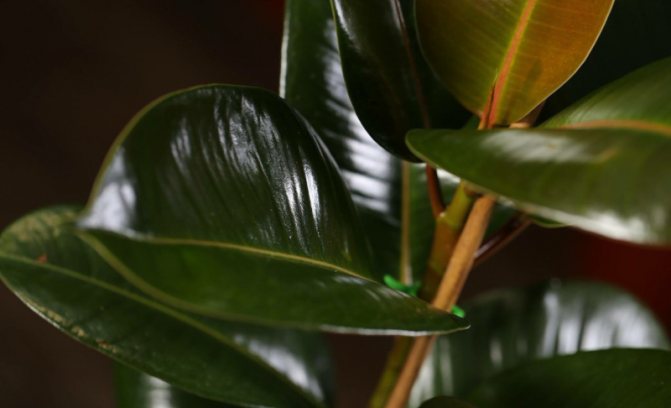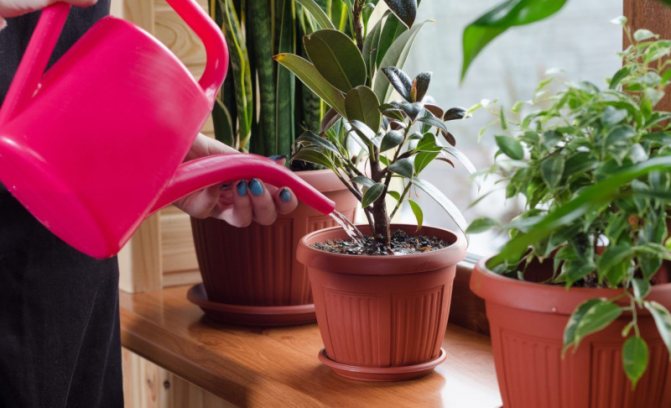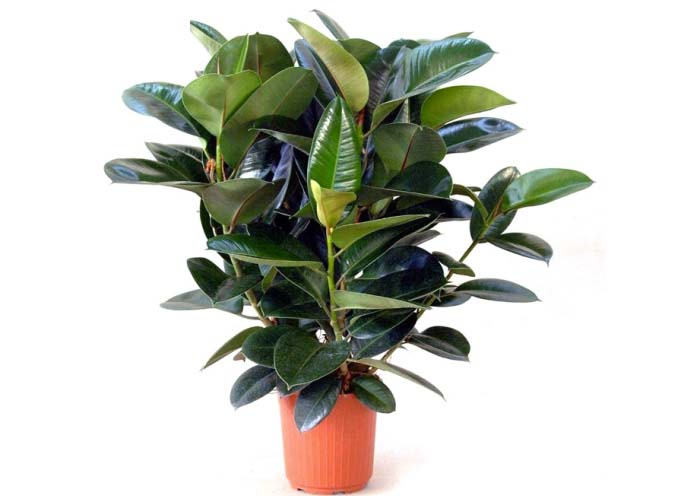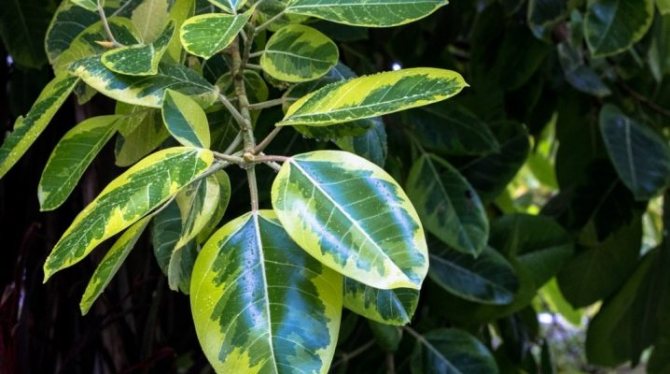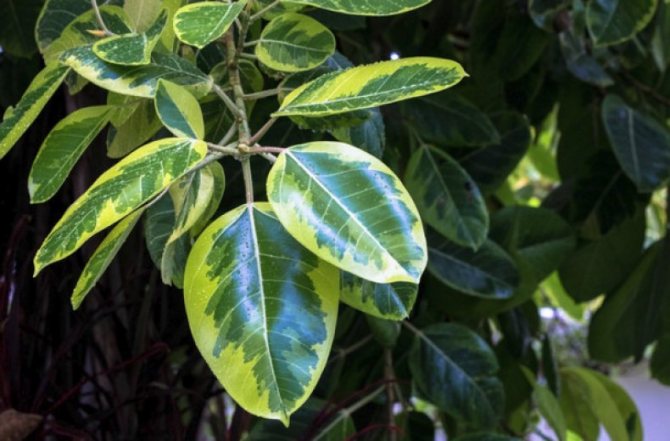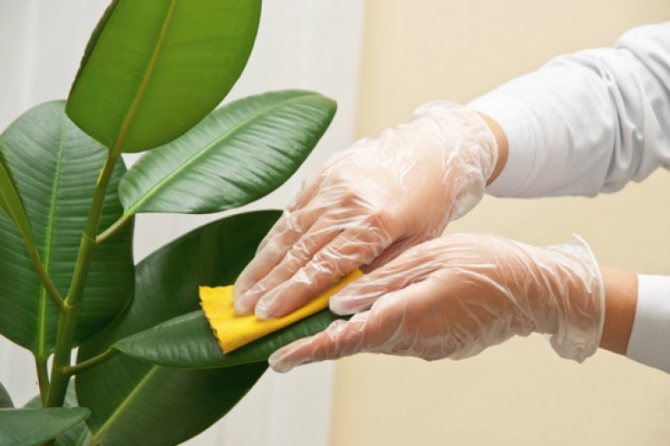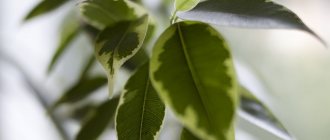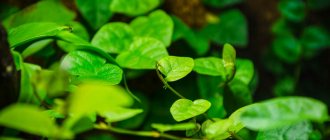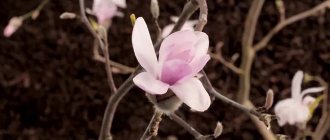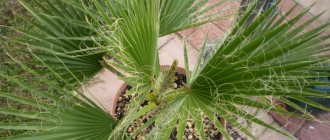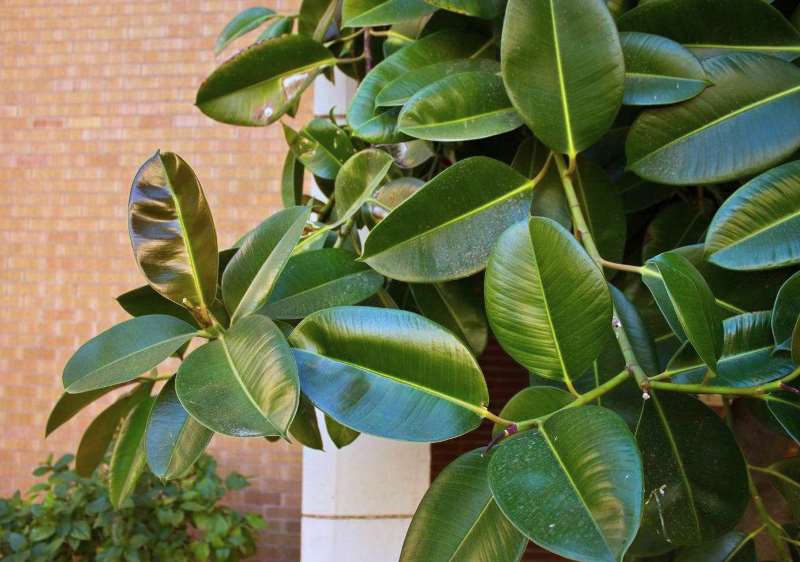
Of more than a thousand species of ficuses, only some varieties are adapted for breeding at home. And the most unpretentious of them is considered to be the ficus Robusta, or, as it is also called, "rubbery" or "elastica". Even the one who first thought about placing a green “friend” on his window can be sure that he can cope with caring for him.
Appearance
Ficus robusta (Ficus robusta) or elastic ficus (Ficus elastica) is an evergreen tree from the Ficus genus, the Mulberry family, the Ficus rubbery species. The native land of the plant is the south of Indonesia (the islands of Java and Sumatra) and the southeast of India (the state of Assam). In their natural environment, the ficus Elastica Robusta looks massive, and can grow up to 60 m in height, while other representatives of the species reach a maximum of 40 m.When grown in a pot for a home or office, a bush ficus or tree stretches in height to an average of 2-3 m ...
Robusta has very decorative leaves - alternate, large (10-20 cm wide and 20-30 in length), dense, leathery, with a glossy sheen, regular oval shape with smooth edges and a sharp, slightly elongated tip. Older leaves are dark emerald, young leaves are pinkish brown. The central vein is clearly visible. Its color ranges from yellow to dark red.
Unlike many indoor ficuses, Robusta blooms in the house. But its yellowish-green inflorescences are so small and invisible that their flowering practically does not change the appearance of the tree. Then in their place appear small, about a centimeter in diameter, oval fruits - syconia. Like flowers, they have no decorative value. You can’t eat them either.
In nature, Robusta forms many long and strong aerial roots. Due to this feature, in India it is used for the cultivation of "living" suspension bridges. Thrown across a river or gorge, they represent the oldest examples of arboarchitecture - a trend that practices the use of living flora at the basis of building structures.
Many people know that initially rubber was obtained from the rubber contained in the sap of tropical trees. However, few people know that the ficus Elastica was the first source of rubbery juice. In Southeast Asia, it was specially grown on plantations for this.
Plant fertilization methods
Ficus Robusta needs fertilization. It is necessary to feed the flower during the growing season. It begins in early spring and ends in late autumn.
It is best to give preference to nitrogen-containing dressings that stimulate leaf growth. Fertilizers are applied 3 times a month. Some gardeners believe that the more often the manipulation is done, the better. Although they do not understand that this is fraught with unpleasant consequences. It must be remembered that a lack is bad, but an overabundance is not the norm.
Ficus Robusta: features of home care
Taking care of the Elastica Robusta ficus is not difficult. He does not need to create any special conditions. But to make the tree look healthy and beautiful, it will not hurt to follow some rules.
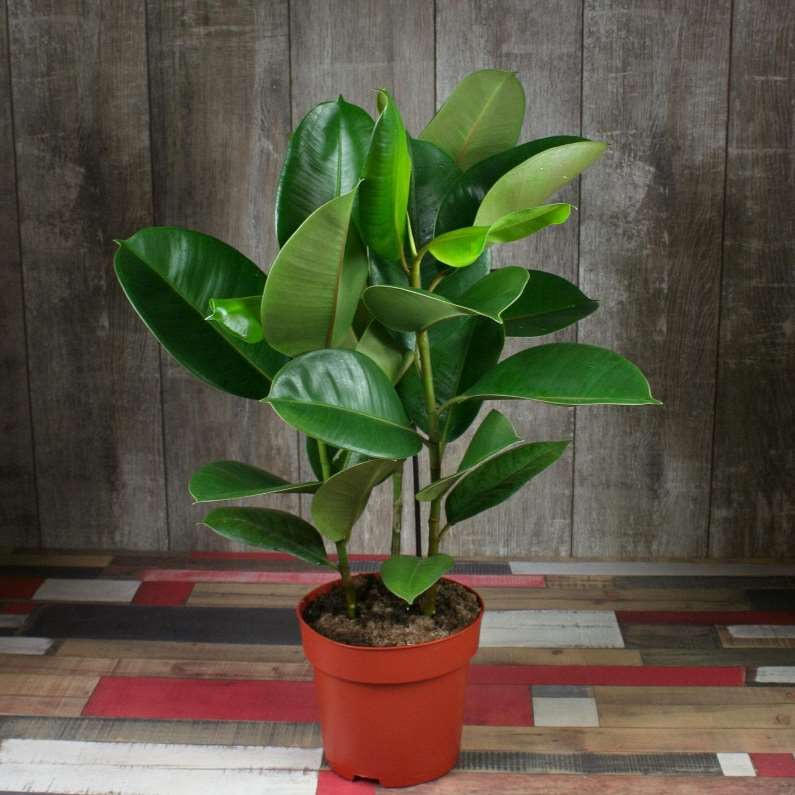

Temperature
Room temperature is ideal for this ficus.He equally dislikes too much heat and excessive coolness and is cultivated exclusively as a house plant in the middle lane. If the air in the room cools or overheats beyond the range of + 15-28 ° C, the tree may begin to shed its green mass. That is why it is recommended to protect it from drafts and keep it away from heating appliances.
Watering
Watering the Robusta ficus is necessary often: in the summer - twice a week, in the winter - weekly, not too abundantly, so that the water does not flow into the pan. Water is taken at room temperature. It is necessary to ensure that moisture does not stagnate, otherwise the root system will begin to rot. Therefore, before watering the ficus, you need to make sure that the ground is dry. The crown also needs moisture and cleanliness - regular spraying with warm, settled water, periodically wiping it from dust with a soft, damp cloth.
Air humidity
A sufficient amount of moisture is one of the main criteria for the competent content of the rubber-bearing ficus Robusta. It is desirable that the humidity in the room where it grows is maintained within 60-70%. In winter, when heating devices are working, a value of 50% is permissible, but spraying in this case is carried out more often.
Lighting
Ficus Robusta differs from its "congeners" in that it does not impose strict requirements on lighting. He feels good both on the south and on the north windows and knows how to get by with a limited amount of light, even while in the shaded corners of the house. And if the place where it is located is very dark, an artificial light source will easily solve the problem. He is much more afraid of direct sunlight. They can leave burns on the crown and cause it to wilt.
The soil
Active growth is ensured by the correct selection of soil. It should be light, with neutral acidity. It can be a universal soil or a special mixture designed for ficuses. So that moisture does not stagnate, the roots do not rot, a drainage layer (expanded clay or sand) must be present at the bottom of the pot. A little sand can also be mixed into the soil, it will improve its breathability. The top layer must be loosened regularly, avoiding the formation of a crust.
Top dressing
During the growing season (from March to November), the Robusta ficus in the house needs regular feeding with ready-made mineral complexes or special nitrogen-based formulations. They have a beneficial effect on the state of the crown, making it thicker and more bright green. The frequency of application is once every two weeks. They are added to the soil in small quantities, according to the instructions on the package. When Robusta enters a dormant state (from November to March), feeding is stopped.
It is better to "underfeed" the plant than, carried away by excessive fertilization, to salt the soil. The same can be said about the concentration of dressings: it is better to dilute them once again than to burn the roots with an overly concentrated fertilizer mixture.
Possible problems
In order for the acquired or newly planted houseplant to be healthy for a long time and decorate the room, the flower should be protected from negative external influences and adhere to the basic rules for caring for the ficus.
- The acquired new plant should be immediately placed in temporary quarantine for three weeks, observing the condition of the ficus.
- It is very important to carry out periodic inspections of the plant and assess the health of the ficus.
- Using a soapy solution weekly when wiping the leaves can help keep the ficus plant free from plant pests.
Strict adherence to the rules for caring for a houseplant allows you to protect it from weakening and damage by diseases or pests.
Reproduction of ficus robusta
Like most representatives of the species, the Robusta ficus can be propagated in several ways: by cuttings, layering, seeds, leaves. In all cases, it is good to use phytohormones to accelerate root formation.
Cuttings
This method is the most convenient and common. The best time for him is the last week of winter - the beginning of spring. As a planting material from which ficus propagates, you can use any cuttings: green, half or completely lignified. Moreover, the apical specimens are preferable to those taken from the middle of the shoot.
The procedure is as follows:
- slices of stems with 2 - 3 leaves are cut from the tops of the shoots;
- milky juice is washed off from the cut points so that it does not clog the conducting vessels;
- within an hour, the sections are dried in air;
- the prepared planting material is planted obliquely in containers filled with light earth with sand or clean sand.
In large-leaved ficuses, and this is exactly what Robusta is, before planting, the leaves are twisted into a tube, they are tied up, and the seedling is tied to a peg to give it stability, which is stuck into the ground through the center of the tube.
The cuttings take root within 20-60 days. Rooting will take place faster in the presence of soil heating, an air temperature in the room of 24-28 ° C and a humidity of about 80%.
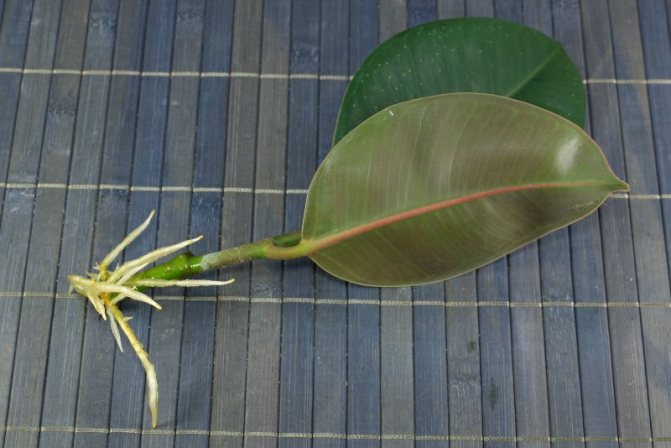

Caring for cuttings consists in keeping the soil in a constant state of moisture and spraying the leaves. To maintain the humidity at the required level, the cutting can be covered with a jar or plastic bag, not forgetting to open it from time to time for ventilation.
Layers
The second most popular breeding method at home is by layering. This is a great opportunity to bring back to life a plant that has lost the lower part of the crown. From adult ficuses for layering, you can take fully formed shoots and even whole branches, which will be much larger in size than any cuttings.
The procedure is as follows:
- an oblique incision is made on the branch you like for the appearance of roots;
- so that the incision does not close, a match is inserted into it, they wrap this place with wet moss, and on top of it with black plastic wrap;
- until roots are formed, the moss is kept moist by adding water under the film with a syringe.
After 2-3 months, when the roots are formed, the branch along with the roots is cut off and planted for rooting in a light nutritious substrate.
Leaves
Only strong and healthy specimens are chosen as planting material for leaf propagation at home. They are cut off along with a piece of the shoot. The cut is made obliquely, impregnated with some kind of root formation stimulant.
For the appearance of roots, the cut off shoot is placed in a bowl with warm, settled water or wet cotton wool. The sheet itself should not touch the water. When roots appear on the cut piece of the stem, a cup is planted for rooting. The process of germination of roots can be skipped with water, immediately after treatment with root-forming stimulants, plant them in a light nutrient substrate, cover with a glass cover or plastic wrap and leave for rooting.
Seeds
This method is usually used in cases where it is difficult or impossible to get material for grafting or cuttings. In order not to be disappointed with the result, it is advisable to buy seeds from well-established, trusted sellers.
Before planting, it is advisable to soak the seeds in a biostimulator for several hours. Then they are laid out on the surface of the soil moistened with a spray bottle. If the planting material is of high quality, seedlings appear in a week.
Benefit and harm
The branches of the plant secrete milky sap. It's great for mining rubber.
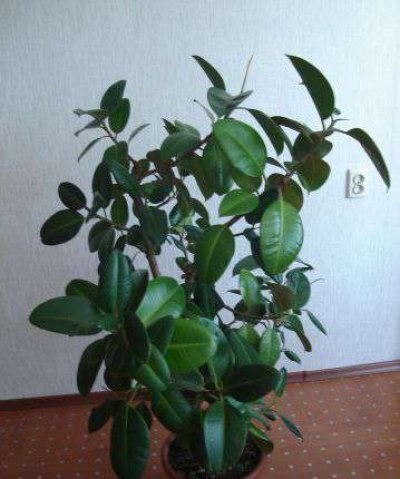

Drops of snow-white dense juice flow out when cutting the stems and leaves of the plant.
On one of the branches, a curved cut is made under the bark. A container is placed in place of the wound. To prevent the juice from curdling, the incision is closed with a bandage previously moistened with alcohol. Vinegar is added to the container and the resulting mixture is mixed well. Flakes appear in the concentrate, which are washed under running water and rolled into elongated strips.
Rubber is subjected to various tests, since it does not dissolve in water and does not swell during precipitation. Such rubber can be easily processed into rubber or glue. More than 60% of natural rubber is used for the manufacture of tires. Large-scale rubber production is used in Thailand, Indonesia and Malaysia.
Transfer
Ficus Robusta in the house, as well as in nature, grows rapidly, so it has to be transplanted regularly. In addition, he needs a transplant after the store. If the plant was purchased already rooted and grown, it cannot be left in the old container. The right time can be determined by the condition of the roots: when they become visible on the surface of the soil, it is time to change the "home" for the flower.
The basic transplant rules are the same for all ficuses:
- The diameter of the new pot should be only slightly larger than the previous one: for small bushes - by 2 cm, for large trees - by 6 cm.
- Young trees are transplanted every year, those older than 4-5 years - every 2-3 years, further as the space of the pot is developed.
- The root collar should not be buried: the place where the roots begin should be felt even in a tall adult tree.
- If a flower is bought or donated, after the store it is given a few days to adapt and only then transplanted.
The most successful method of transplanting is considered to be transshipment, when the tree moves along with the earthen clod, so that its root system is not injured. The tree is watered abundantly, carefully removed from the old container, the trunk is installed in the center of the new container, at the bottom of which drainage and some soil have already been poured, and the empty spaces around it are filled with fresh earth. Then the soil is lightly tamped and poured so that a distance of 2-3 cm remains from its surface to the edge of the pot. This will provide more convenient watering. At the end of the procedure, the flower is watered again. The transplant is carried out in the same way after purchase.
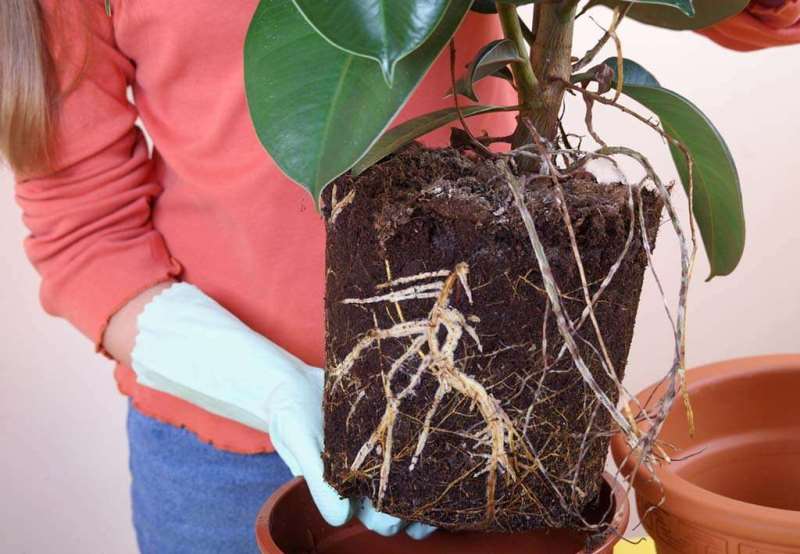

When transplanting, an adult plant often remains in the same pot, only not rough cleaning of the roots from old soil and replacing it with fresh one is done. The same situation occurs during transplantation, due to the fact that the plant has lost some of the roots as a result of overdrying or overflow and decay.
The required amount of moisture
The plant requires regular spraying. In winter, twice a day. In summer - a little more often. Spraying is carried out with filtered water.
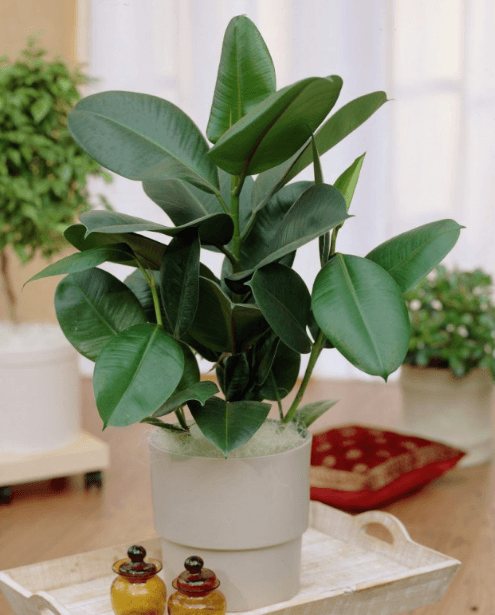

Under normal lighting, the plant should be watered abundantly, but it must be borne in mind that excess moisture can lead to decay of the roots.
Watering schedule:
- several times during the day in summer;
- once every 4-5 days during winter.
If water remains in the pan after watering, this can lead to mold and disease in the plant.
Crown formation and pruning
In its natural environment, the ficus Elastica generally grows only upward and to a gigantic size. Robusta at home does not reach the same height as in nature, but still, so that it does not reach the ceiling rapidly, it looks neat and decorative, it needs pruning and crown formation.
All work is carried out in early spring, during an active growing season. This will awaken the axillary buds from which the lateral shoots develop. It is better not to touch Robusta from the end of October to the middle of January.
There are several rules on how to properly trim ficus:
- Shoots are cut at a height of 3-5 leaves from the top, without leaving a hemp in order to prevent the appearance of fungi or rot.
- Thin stems are cut straight, thicker ones - at an angle.
- The wounds are treated with crushed coal or an antifungal solution.
If a transplant into a new pot is required, it is carried out either 3-4 weeks before trimming the ficus or 3-4 weeks after.
Formative pruning involves not only shortening the shoots, but also guiding them in the right direction using wire and tensioning devices. Before pruning, the shoot is fixed in a certain direction. After a while, the wire can be removed.
To obtain a more lush crown, pinching of the tops is carried out. Unlike other ficuses, Robusta, after removing the top, sometimes does not give a "fork" and continues to grow into one shoot.
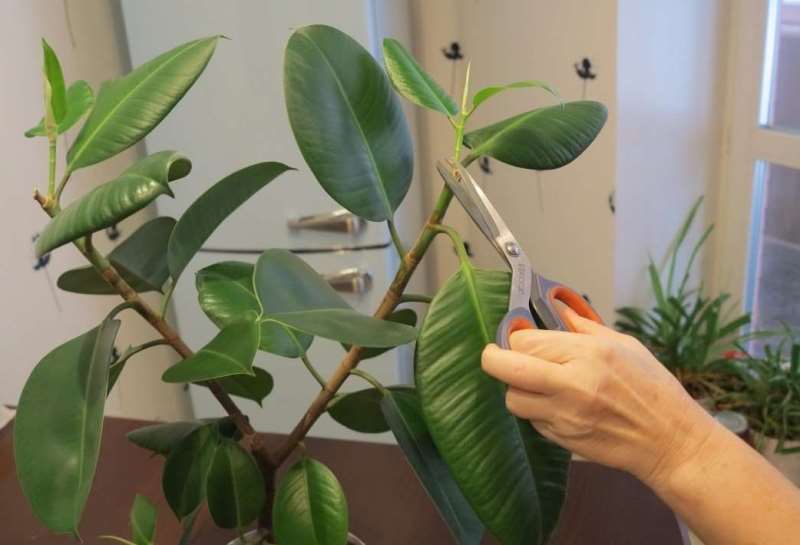

Despite the fact that the Robusta ficus is evergreen, the lifespan of its leaves is limited. Therefore, in addition to formative, he also needs sanitary pruning. It is carried out as needed throughout the year.
The soil
Ficus needs a light and nutritious soil without acidity. For such plants, special or universal soils are sold. In order for the air to pass better, sand and vermiculite are added there.
Fertilizing ficuses is encouraged. Especially when it is actively growing and developing. It is recommended to feed them from November to March.
A top dressing is used, which is sold in liquid form and is intended for decorative deciduous plants. Let it be a composition in which there is a sufficient nitrogen content. The application procedure is carried out once every two weeks.
Diseases and pests
Ficus Robusta is resistant to diseases and pests. Of the latter, it is most often attacked by spider mites. A good result when getting rid of it is given by spraying and washing the leaf plates, as well as putting a plastic cap on the crown for 3-4 days. Most diseases are the result of improper care: sunburn or lack of lighting, excessively high air temperatures or drafts, waterlogging or lack of moisture, frequent change of location. The main problems that you can face:
- Ficus has dropped the leaves, they dry and fall off. Sometimes adult specimens shed green mass in order to renew the crown with new shoots. But more often this phenomenon is caused by dry air, insufficient watering, depletion of the soil or exposure to pests.
- Leaves curl. Most often, the reason is improper watering: the plant either receives less moisture, or receives it in excess. How can I save him? Optimize watering.
- Leaves turn yellow. Iron deficiency is a major contributor to yellowing. To eliminate it, the soil must be fertilized with iron chelate or ferrovite.
- Leaves turn black. Perhaps the black spots and dots are sunburn. The danger is that pests can easily penetrate into such places. It is best to remove the affected leaves, treat the roots and crown with a fungicide.
- The trunk rots. Once again, remember how often you need to water the ficus. This is most likely the problem.
Photo
In the photo, the ficus "Robusta":
Interesting Facts
Ficus elastica Robusta can be safely kept in both residential and public and office premises and not only for interior decoration. This flower perfectly cleans the air of toxins, and also, according to legends, serves as a talisman against dark forces.
There are many superstitions associated with the robusta ficus. One of the most interesting is related to pregnancy. It is said that given to a childless couple, it has magical properties and helps to have children. To get what they want, parents-to-be should put the green friend in the bedroom and take good care of him.
Another sign for the Robusta ficus - despite the fact that its flowers are small and inconspicuous, its flowering means a quick profit or a large gift. Perhaps that is why tubs with this rubber can often be found in the accounting departments of various institutions.
Many people doubt whether it is possible to keep this plant at home. Reviews of experienced fig growers say that it is not only possible, but also necessary, especially in the children's room. It cleans the air from toxic fumes, phenolic compounds, trichlorethylene and benzene, emitted by synthetic materials from which furniture, decoration and many objects in the house are made.
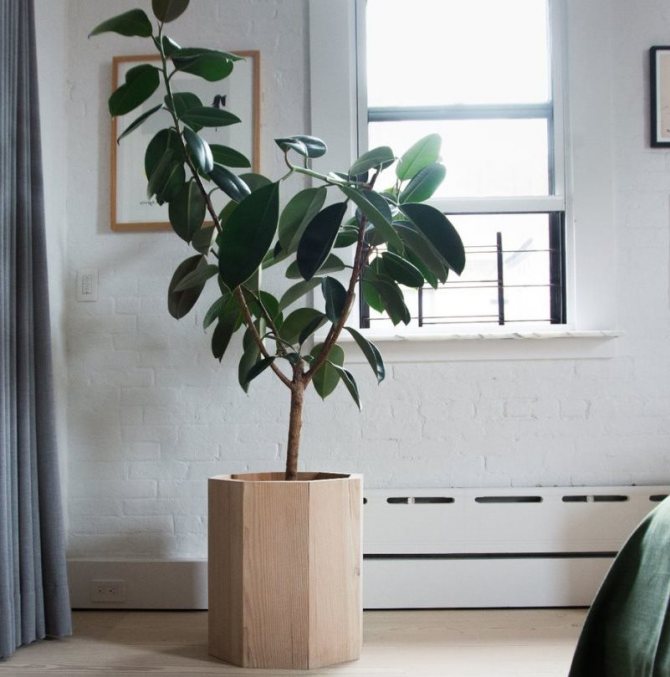

According to Feng Shui, ficus is considered a symbol of well-being, wealth and prosperity. The one who starts it at home receives a powerful source of energy every day. For those who are with him, he acts as a psychotherapist: he calms irritable people, and gives self-confidence to indecisive people. And how true this teaching is, you can find out by growing Robusta elastic at home.
Are there really bad omens about the ficus in the house ?!
Plants living in apartments affect humans.
Some flowers help to find family happiness, while others, on the contrary, expel the soul mate from the house.
Some esotericists believe that ficuses, like ivy, belong to "muzhegon". Experts refer to the opinion prevailing among our ancestors. The Slavs were suspicious of the guest from warm countries: they believed that there would be no happiness and harmony in the house where this flower grows.
I strongly disagree with this opinion. Suffice it to recall that the ficus was a very common plant in the century before last and, along with geraniums, was considered a sign of philistinism. And what does this concept mean if you understand it without class hatred and ideological undertones. In fact, it is a quiet, peaceful, comfortable life in which there is no place for revolutionary ideas, loud quarrels, scandals and drunken shouts. Philistinism is kindness, calmness and silence, wealth and prosperity. Is it bad!
Remember how well-to-do townspeople and strong, hard-working peasants lived before the revolution: there were huge rubber ficuses in a tub in their houses, and a cuckoo clock hung on the wall.
I highly recommend keeping a positive plant at home.
Difficulties in growing
The most common mistakes novice florists make:
- Yellowed leaves, their constant dropping. Reasons: draft, lack of moisture, improper lighting.


- Brownish spots on the leaves. Reason: excess moisture. It is necessary to reduce watering, or better - to stop altogether, wait for the soil to dry out by 2-3 cm deep.
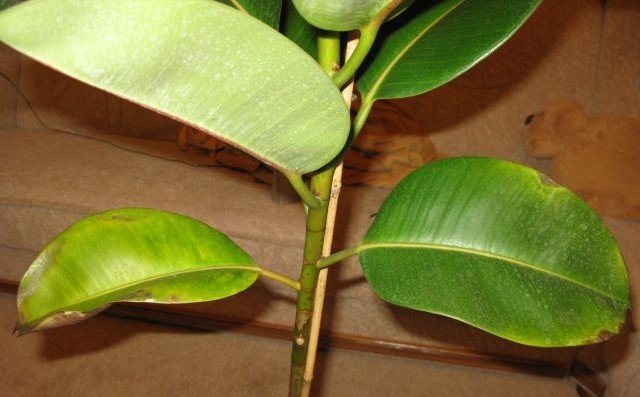

- The bush shed its leaves abruptly: stress. A sharp change in temperature, drying out, followed by watering with cold water. It may be necessary to restore the plant by cuttings, if the growth of shoots has not stopped.
- Spider mite... Reason: very dry air. Treat the plant from a spray bottle with a special agent, first isolate it from other indoor flowers.
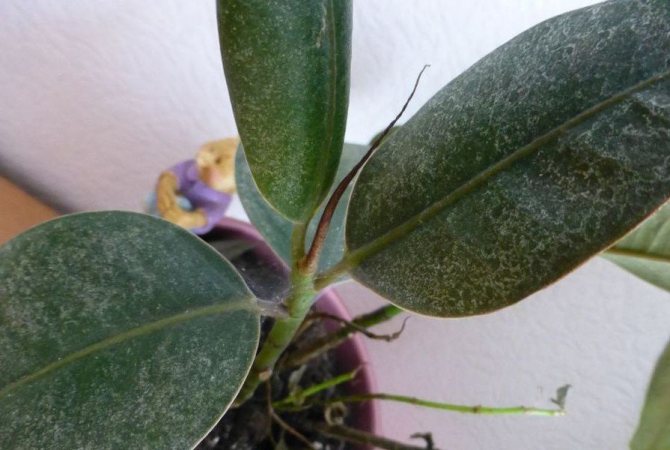

Folk omens and superstitions
Exotic appearance and the ability to purify the air from accumulated phenolic and benzene compounds contributed to the appearance of "supernatural abilities" in indoor ficus:
- cleansing the aura of the home from negative energetics;
- protection from evil spirits;
- maintaining the financial balance in the house;
- balancing the irascibility of the owners.
Did you know? Suspension bridges are woven from the aerial roots of giant elastic ficuses in Indonesia.
Proper care and maintenance contribute to the emergence of a new family member: Robusta will thank you for taking care of clean air, a feeling of warmth and comfort in the house.
How to care?
Caring for ficus robusta at home is especially important immediately after purchase. The fact is that the transfer of a plant to a different atmosphere, a different microclimate is a stressful situation. Therefore, for the time of adaptation, the ficus will have to be kept separate from other plants in a room with good lighting, but where direct streams of light do not fall, and also observe the watering regime. In general, Robusta feels good even on the windowsills of windows facing north, so it can be placed in a shaded place next to the loggia or windows.
Ficus robusta should not be planted next to the battery, since exposure to hot air leads to an acceleration of evaporation processes, which means that the bush may well get burned. In the off-season, that is, in autumn and spring, it would be good to move the plant to the loggia. In summer, if possible, it is even allowed to take it outside in case of sufficient exposure to sunlight.
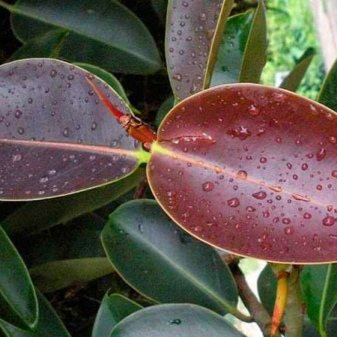

As for the temperature, then the bush feels good in the range from 18 to 25 degrees Celsius, that is, at normal room temperature. Smaller or larger degrees already negatively affect the development of culture, for example, leaves begin to fall off. If we compare the flowering of home ficus with what happens in the wild, we can say that it passes almost imperceptibly.
The sizes of both fruits and flowers of a beautiful green shade do not even reach 1 centimeter. Humidity must reach at least 50%... If in winter such an indicator cannot be obtained naturally, then it is worth either introducing regular spraying, or installing a humidifier in the room.
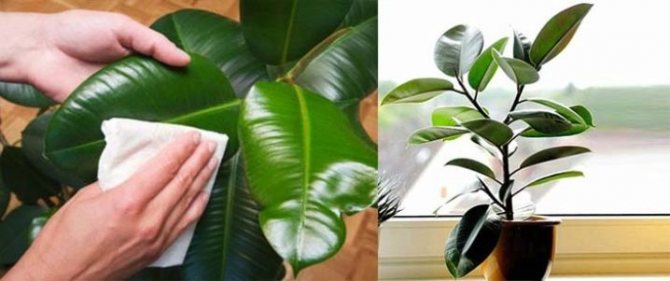

Top dressing
Ficus robusta prefers a soil mixture filled with useful elements: minerals and salts. Experts recommend purchasing ready-made soil in the store, making sure that it has good air permeability. Plant the bush correctly in a fairly large pot, and then transplant in addition every year. It is more convenient to take ready-made complex solutions as fertilizers that have a large amount of nitrogen in their composition. By the way, mature ficuses are almost impossible to transplant, so they just regularly change the top layer of the soil mixture.
Most of the fertilizer for the ficus is applied while it is actively growing, that is, from the beginning of spring to the end of autumn. At this time, feeding is planned every 2 weeks. Experts recommend giving preference to such proven formulations as "Ideal", "Gumisol" and "Palma". It is not forbidden to carry out foliar dressing.
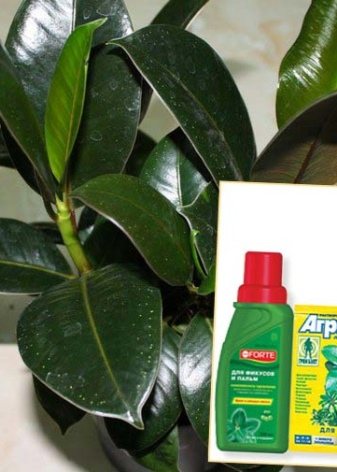

Watering
It is important to irrigate ficus robusta regularly and in large quantities. Of course, it is categorically not recommended to fill it in - excess liquid leads to decay of the root system, as well as an increase in the acidity of the soil. It will be possible to prevent trouble by organizing a drainage system, for the manufacture of which either a composite or pebble stones are required. It is important to let the soil dry out before watering again.
In principle, a good solution would be to drain the remaining water from the pan after the ficus has absorbed the amount of moisture it needs. This preventive measure will help protect the bush from mold. In the warm season, it is customary to water the ficus every 3 days, and in the cold season it will be enough once every 5 days.
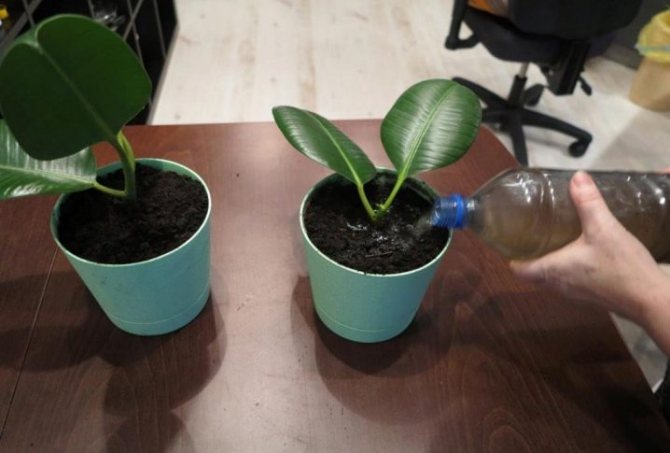

Fight disease
Ficus robusta is more susceptible to disease than pests. Sometimes spider mites are found on large leaves, but getting rid of them does not require special measures - it is enough to rinse the bush with cold water without touching the soil, and then wipe the leaves on both sides with moistened napkins. As for diseases, their main causes are improper crop care or some kind of stressful situation, for example, a transplant. As a result, ficus leaves fall off or change color, and the stem slows down its development. By the way, the disease may be "delayed" - its symptoms will appear only after a few months.
Falling or yellowing leaves can signal the presence of a draft or insufficient irrigation. Brown specks on the leaves occur due to excessive watering. For the same reason, rotting of the root system, accompanied by an unpleasant odor, also manifests itself. When robusta sheds leaves very abruptly, at a time, this indicates that the state of the plant is critical, immediate intervention is required.Sometimes crown shedding occurs due to very dry air.
Pruning
There is no need for a gardener to form a crown of a ficus robusta. At home, it is customary for the plant to be given the opportunity to grow in the same way as it would happen in nature. If the lateral stems do not develop well, then you can cut off the top of the bush to stimulate them. If the desire to create an unusual crown is still present, then it is better to do it at the junction of February and March, when the ficus is preparing for active growth. The basic rule for crown formation is to trim 7 centimeters higher than required.
Poisonous or not
According to the latest data, the culture is recognized by scientists as poisonous. It does not carry a mortal danger, with the exception of allergy sufferers, but when it gets on the skin of milky juice, it can provoke redness, itching, burning, blistering. It is important not to allow the presence of plant parts in the hands of babies. Small children taste everything. In this case, Benjamin's ficus can lead to poisoning, provoke gastrointestinal diseases. Culture is also dangerous for pets.
People with allergic reactions, especially latex, should raise this breed with care. The juice can cause severe damage to the skin. In case of contact with the face, you must immediately wash, rinse your eyes, take an antihistamine. Perhaps the development of bronchospasm, Quincke's edema.
It is not worth giving up the ficus, but safety precautions must be observed - when processing, caring for the bush, wear gloves, close the respiratory system and eyes.
Abidjan / Abidjan
Abidjan is another unusual and unpretentious ficus native to the Asian tropics, which also looks like a dark mysterious guest.
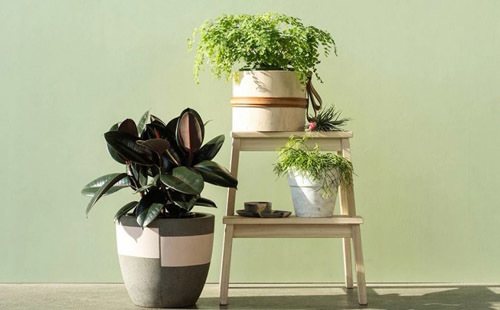

The color of young foliage is close to red, and in adulthood, the red tint remains on the back.
The leaf of an adult Abidjan is matte, dark green with yellow veins, elongated, up to 25 cm long. The ficus itself most often grows up to 1.5 meters, has a main powerful stem, several graceful shoots that form a crown.
In general, this tree is a non-capricious migrant. He loves warmth and moisture, but adapts to any conditions.
At the same time, due to correct pruning, the decorative features of the plant can be improved. Plus, it is very desirable to provide him with regular, but moderate watering.
How to avoid the consequences predicted in the signs
Sometimes flower growers prefer not to start a beautiful plant, fearing superstitions and signs. Experts say that first of all it is necessary to take good care of the tree and not tune in to negativity. Only in this case Benjamin's ficus will bring happiness and good luck.
To prevent bad omens, you need to choose the correct arrangement for the flowers in the house. According to superstition, a small tree should not be positioned:
- away from windows and sunlight;
- on the north side;
- on the windowsill by the west window.
These places are unfavorable for growth. Located in an unfortunate place, the flower spends all available forces to maintain its life. Thus, he will not be able to help create harmony and a friendly atmosphere in the house.
Attention! In order for good omens to come true, you need to properly and diligently take care of the flower.
To add to the family
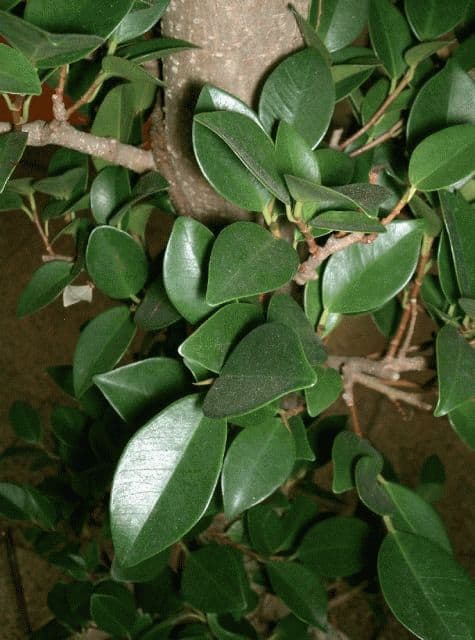

A separate conversation: ficus and children. Not already present, but potential. He is considered to be very useful for people wishing to become parents
, especially for mothers (because this requires more effort and sacrifice from women). Especially good omens speak of the rubbery ficus.
Positive energy helps:
- cope with diseases of the reproductive system (ovaries, uterus);
- adjust the menstrual cycle;
- get pregnant;
- maintain your health during pregnancy.
Best of all, a donated ficus "works" to improve the reproductive position. Purchased on its own will do too, but the effect will be somewhat less noticeable and quick.
In the East, he is considered positively affecting male strength
... Not the one that moves the furniture, but the one that gives pleasure and conceives children.
Ficus elastica: photos and pots ideas
Where is the best place to put the plant
There are also signs for the house associated with Benjamin's ficus. The location of the tree in the living space is important.
The flower can be placed on the east and south sides. The proximity to the light is important, since the energy of the tree can fully unfold. It will bring harmony and peace to the home.
In China, trees are placed on the windows. People are convinced that the flower harmonizes the home and gives comfort.
This plant is especially useful when placed in the kitchen. According to superstition, residents will not have to feel the need for food. For this purpose, it is recommended to bury a coin in a pot. Along with the growth of the tree, well-being increases. The family will always be loving and happy. The house will have prosperity and a comfortable atmosphere.
Ficus Benjamin, located in the kitchen, will help build relationships between relatives. Any variety is believed to help fight germs in the kitchen.
Attention! A plant located in the kitchen can reduce appetite.
Signs also refer to Benjamin's ficus and pregnancy. If a woman plans to conceive a child, the plant should be placed in the bedroom. To make the man confident in his abilities, the tree is placed next to the bed.
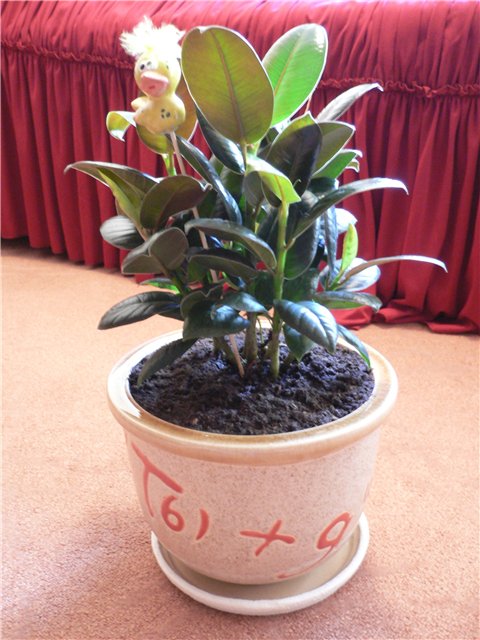

There is a superstition that walking around the tree tub is conducive to conception. You can also ask for a scion from a family with children.
A small tree growing in the bedroom improves sleep and eliminates nightmares. If the plant is in the living room, it attracts important people to life.
Different types of unpretentious plants can be grown in office premises. A tree growing at work is a sign of a good mood. Flowers help you focus and focus.
Features and characteristics
The rubber-bearing ficus robusta is a tall tree belonging to the mulberry genus. The homeland of the plant is Indonesia and China, but in nature it is also found in Nepal, China and India. Robusta is the tallest of the ficuses: some of its representatives reach heights exceeding 60 meters. The diameter of the trunk can be several meters, and in room conditions, being much smaller, it can branch out significantly. The crown of the ficus does not expand with age, but the roots can overtake the soil by growing.
Elastica differs from its "relatives" in leaves - wide, wavy and shiny. The width of one leaf can exceed 20 centimeters, and the length can reach 40 centimeters. However, most often the length is in the range from 20 to 25 centimeters, and the width is 15 centimeters. Young plates sometimes form a kind of envelopes, which then fly around.
The edge of the leaf looks inward. If you touch it, you will get the feeling of a waxy coating.
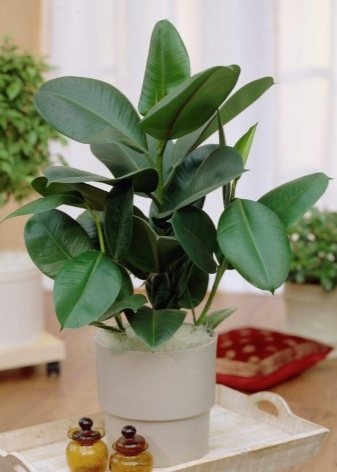

Ficus parts change their color over time from red-green to pure emerald. The leaflet description also contains information that the shape of the plate is rounded, reminiscent of an oval, but with a sharp tip pointing down. Finally, the leaf has a distinct red or green vein in the center and a short pale petiole. On a green trunk, the leaves are arranged sequentially along its entire length.
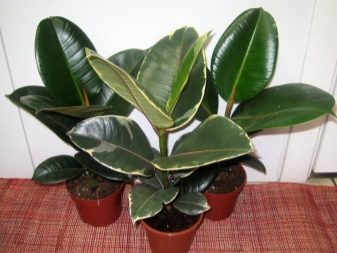

Who can give a flower
The donated ficus of Benjamin is the best option for purchasing a tree. If it is given by good friends, it will attract luck and good luck to life. Folk omens say that it is very good to give ficus when it blooms. In general, flowering indicates the fulfillment of hopes and wishes, an increase in well-being.
A variety of Benjamin can be gifted to everyone, without exception. The tree often becomes a gift for married couples who dream of adding to the family.
Important! A plant will only be able to reach its full potential if it is properly cared for and cared for.
How to choose?
It is better to postpone the purchase of ficus for the spring or summer months - that is, the time of active growth of the plant. If the purchase takes place in the winter, then you should be prepared for the fact that the ficus will not be able to adapt to the new atmosphere. This is especially true for a novice gardener who is not able to immediately provide the required levels of humidity and temperature, as well as to establish a care system. Choosing a Robusta in a store, you will definitely have to carefully examine it. If the leaves, stems or roots that are visible through the drainage holes show incomprehensible spots or traces of damage, then the purchase should not be made.
It is right to choose fresh bushes that have recently been brought to shops that have not stood there for too long. It is worth shaking the ficus - if many leaves leave it, then you should not take such a plant. Ideally not a single sheet should fly off. An alternative to shaking is to stroke the plant against the leaves. In addition to general inspection, Robusta should also be checked for mealybugs. Taking the ficus home, it must be carefully packed so as not to freeze.
Experts advise against taking large mature specimens. The fact is that the older the plant, the more difficult it will be for it to adapt to the new environment. The roots of a healthy plant should not be black or dark brown. It is worth mentioning that often in stores, ficus leaves are rubbed with polish to achieve a beautiful shine that attracts customers.
When you get home, the solution must be washed off, since its chemical composition clogs the surface mouths and interferes with the provision of normal gas exchange.
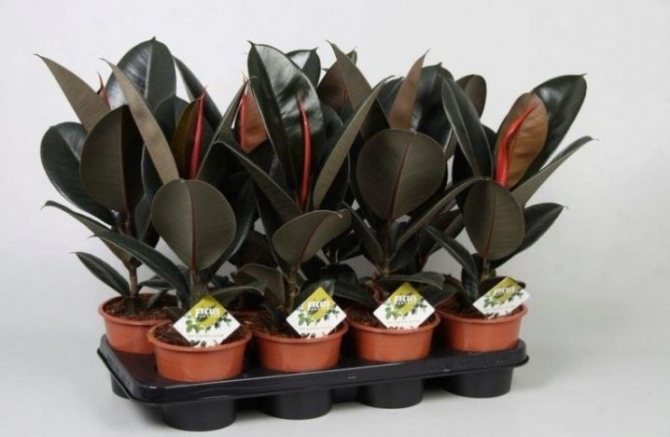

Melany / Melanie
This variety differs markedly from the previous ones. Melani ficus is the shortest, rather dark, bushy well.
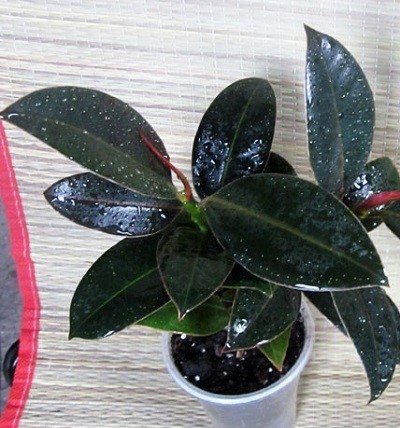

This ficus was bred by Dutch breeders and combined beauty and compactness.
At a young age, the plant has an unusual reddish tint of leaves that changes to dark green. The leaves of an adult ficus are thick and glossy, up to 15 cm long. The back of the leaf blade is olive, with red veins, rough.
As the ficus melanie grows, it lets out several shoots, while its height does not exceed 30-50 cm. With proper care, the bush retains its splendor and stands out beautifully in the interior. But he, like variegated graceful flowers, requires attention!
This variety is especially suitable for small rooms, and if you want to create a garden on the windowsill.
Distinctive advantages
The melanie bush tolerates pruning well, suitable for experiments with crown formation.
What conditions need to be created at home
Easy to care for, unpretentious to conditions - an exact characteristic of rubber ficus. It grows intensively, growing up to 2 meters in three years with proper care.
Lighting
It adapts well both on a brightly lit windowsill and in a slightly shaded corner of the room. You can add artificial color. Ficus itself will tell you that it needs it - the leaves will fade a little.
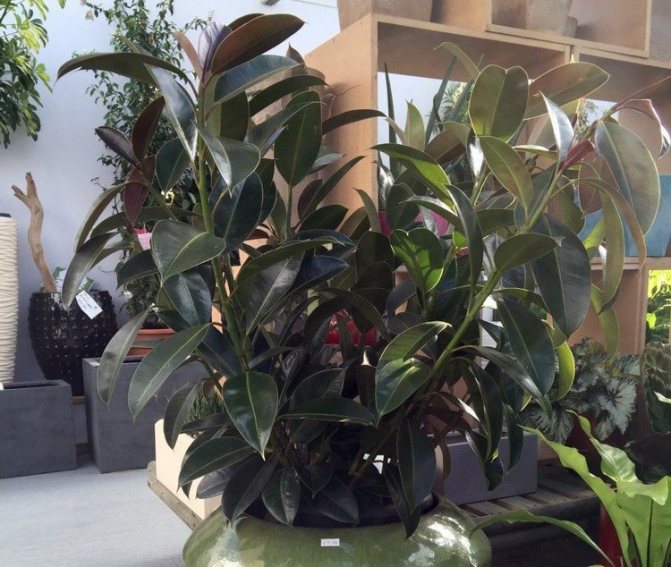

Direct sunlight, on the other hand, can burn sheet plates. Better to find a "middle ground": sunbathing in the morning and light shade throughout the rest of the day.
Airing
Ficus Robusta is unpretentious to temperature, but drafts should not be abused. At optimum air temperatures (+ 18 ... + 25 ° С), it is better to keep the windows or the window in the "airing" mode.
In winter, the plant can be “walked” on a glassed-in balcony on a sunny day. Such an event promotes the formation of chlorophyll, the leaves will be rich in color, with a glossy surface.
At home, they also grow such types of ficuses as:
Temperature regime
Robusta is a resident of the South, and does not tolerate low temperatures. A decrease in temperature less than + 10 ° C will lead to yellowing and foliage falling off. Too high a degree (from + 30 ° C or more) will dry out the air, the plant will begin to intensively absorb moisture from the soil and the surrounding air, will quickly lose its appearance: the leaves will curl and turn yellow, the growth of the trunk will stop and the formation of new leaf plates. The optimum temperature of the content is from + 18 ° C to + 25 ° C with proper watering.
Air humidity
Too dry air will damage the "health" of an exotic pet, but it is not necessary to oversaturate the room with moisture either. The best indicator is 50%, allowing the ficus to develop in the right direction: to form new leaves and release side shoots, at the same time helping to purify the air and create a beautiful interior.
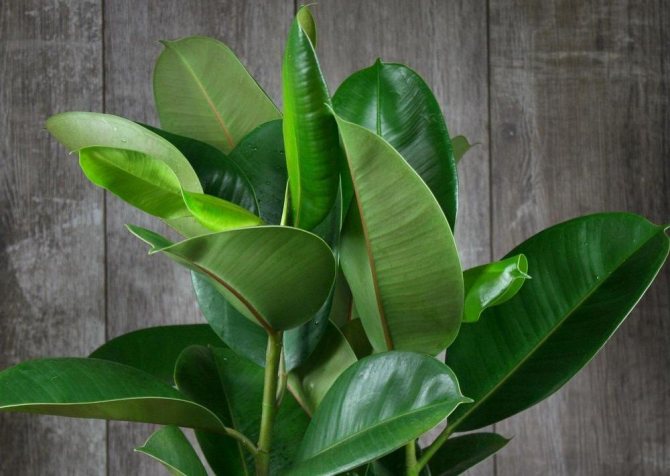

With a natural decrease in humidity in spring and autumn, you can additionally use a spray bottle, as well as clean the surface of the foliage with a cloth soaked in water.
Positive signs
Feng Shui experts from the Celestial Empire endow the ficus with the properties of a talisman that will surround you with comfort and "sweep" negative energy out of the apartment.
They are absolutely sure - the flower will surely attract monetary well-being and good luck in business. Such a house tree will help those who are financially difficult.
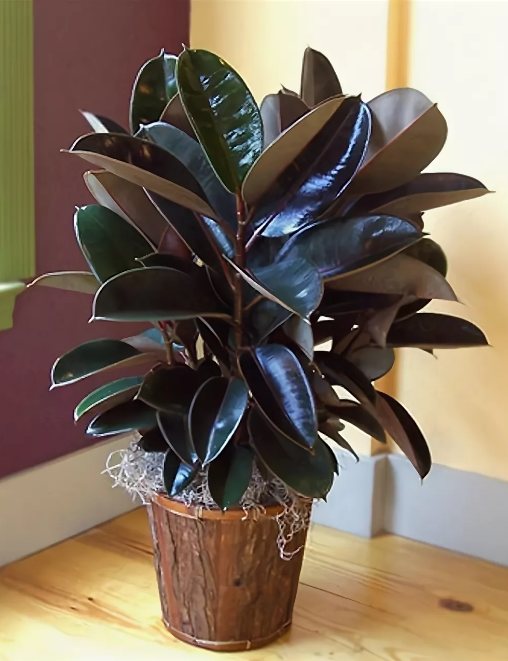

Yes and from the scientific side, its benefits are more than obvious... The plant absorbs in itself all the chemicals released by furniture and wall decoration.
Important! In the bedroom, one flower can do it, but in the kitchen, living room, bathroom, it is better to place several of them at once.

